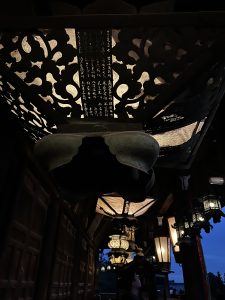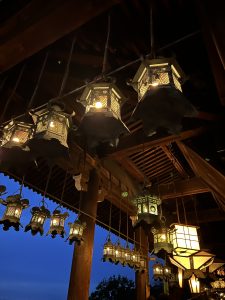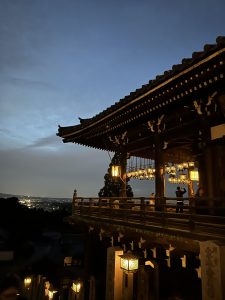釣燈籠の魅力(愛知県名古屋市千種区姫池通 骨董品買取 古美術風光舎)
2024.03.28
みなさまこんにちは、スタッフYでございます。
先日3月27日は「さくらの日」だったようですね。ですが、今年はどうもこの寒気の影響でしょうか、9日ほど開花宣言が遅れているようです。先日はやっと愛媛・松山市や福岡市で開花の発表されたようですが、列島が開花ラッシュとなるのはまだまだのようですね。(待ち遠しい…)
開花宣言が遅れているということなので、東京では飲食店や人力車の仕事に“サクラショック”の影響が出ているようです。また、今週末にすでに花見の予定の決まっているグループですと、固い蕾の桜の下での宴会になりそうでちょっと残念と思っている方もおいででしょうが、入学式などにはベストなタイミングに桜の写真が撮れそうな気がいたしますね。この時期、桜の開花に翻弄されるとは、これも日本ならではなのでしょうか笑。
弊店でも4月5,6,7,日「器と骨董展」を開催を予定しております。また、同日にご近所の覚王山祭りも開催されてますので、その頃桜が満開であってほしいな…と、ひそかに願っております。なにかいい願掛けはないでしょうか…。
と、いうわけで通常のブログに戻っていきましょう。

さてさて、先日釣燈籠なるものがお店に登場いたしました。つい最近のブログにおいて個人的な古い物の楽しみ方をつぶやいていたのでのすが、まさにそのとおりの古い物でありました。
時代を飛び越えて佇まう古い物は、逆に現代の空間や生活に知らず知らず上手に馴染んでいるように見える模範のような釣燈籠でして。空間が一気に面白くなるんですよ、しかも自然に。
そんな釣燈籠、改めて眺めてみますと面白い存在です。
平安時代の絵巻にはすでに宮中の清涼殿に釣灯籠を掛けた画面があったり、社寺以外でも古くから使用されておりますので、その歴史は古いようですが、特に有名なものはご存知春日大社や厳島神社の回廊の軒に吊下げた献灯でしょうか。
また、社寺に奉納する風習は平安時代頃からあったようでして、そういえば先日訪れた東大寺の二月堂にもあった大きな釣燈籠にも奉納者のお名前が記しておりました。あちらも献灯でしょう。



在銘の遺品としては岐阜県の長滝寺に献灯された,元応1 (1319) 年作の『鍛鉄釣灯籠』 (重文,京都国立博物館) が最古の現存の釣燈籠のようです。また、鋳銅のものとしては厳島神社の正平 21=貞治5 (66) 年作が古いもののようです。たしか数年前に厳島神社に訪れたのですが、全く記憶に残っておりませんで、なんとも勿体ないことをしております。
また、材質は銅,鉄,木材で、それぞれ工芸的手法で装飾が施されておりますが、なによりそのデザインが意外と自由でチャーミングなこと、そしてその細工の細やかさには驚きます。さらに、それらに灯がともると、暗闇に細工が浮かび上がり、灯に暖かさが生まれてきます。

残念なことに、この釣燈籠に灯は灯せないのですが、少し目を閉じ、そこに暖かい灯が灯った燈籠を勝手に思い浮かべてみるのですが、どことなく気持ちだけは暖かくなってくるような…。
脳内で勝手に点灯するのは自由のようですので、勝手に点灯して空間を面白くしてみたいと思います。
それではごきげんよう。
Hello everyone, this is Staff Y.
The other day, March 27th, was “Cherry Blossom Day”. However, this year, the declaration of blooming has been delayed by about 9 days, probably due to the cold weather. The other day, Matsuyama City in Ehime and Fukuoka City finally announced the blooming of cherry blossoms, but it seems that the archipelago is not yet in the blooming rush. (I can’t wait…)
The delay in declaring the cherry blossoms has apparently caused a “sakura shock” for restaurants and rickshaw operators in Tokyo. Some people who have already made plans to go cherry blossom viewing this weekend may be disappointed to find that they will be having a party under the hard buds of the cherry blossoms. Is this a uniquely Japanese thing to be at the mercy of the cherry blossoms at this time of the year?
We are planning to hold the “Vessels and Antiques Exhibition” on April 5, 6, and 7. I am secretly hoping that the cherry blossoms will be in full bloom at the time of the Kakuozan Festival, which will be held on the same day in our neighborhood. I am secretly hoping that the cherry blossoms will be in full bloom at that time.
So, let’s get back to the regular blog.
Well, a few days ago, a new type of lantern appeared in our store. In a recent blog entry, I wrote about how I personally enjoy old things, and this is exactly what I meant.
This tsuritonro is an example of how an old object that has jumped over time seems to fit in well with the modern space and life without knowing it. The space becomes interesting at once, and naturally.
Tsuri Lanterns are interesting to look at again.
Tsuri-toro lanterns have a long history, with scrolls from the Heian period (794-1185) showing tsuri-toro hanging in the Seiryoden (a traditional Japanese-style room for enjoying the cool of the evening) at court, and they have also been used outside of shrines and temples for a long time.
The custom of offering votive lanterns to shrines and temples seems to have existed since around the Heian period (794-1185), and come to think of it, there was a large hanging lantern in the Nigatsudo Hall of Todaiji Temple that we visited the other day with the name of the dedicator on it. It was probably a votive lantern as well.
The oldest surviving tsuriton lantern with an inscription is the “Wrought Iron Tsuriton” (heavy cultural property, Kyoto National Museum), made in 1319 and dedicated to Chotakuji Temple in Gifu Prefecture. The oldest cast bronze lantern is a “Wrought Iron Fishing Lantern” dated 1319 (Important Cultural Property, Kyoto National Museum), which was made at Itsukushima Shrine in Shohei 21 (66). I visited Itsukushima Shrine several years ago, but I have no memory of it, which is a shame.
The materials used are copper, iron, and wood, each decorated in a craft-like manner, but above all, the designs are surprisingly free and charming, and the craftsmanship is very detailed. When lit, these lamps give off a warm glow in the darkness.
Unfortunately, you cannot light these lanterns, but if you close your eyes for a moment and try to imagine the lanterns with warm lights on them, you will somehow feel warmer.
It seems that I am free to light the lanterns in my brain, so I would like to light them on my own to make the space more interesting.
Have a good day.
*******************
ご実家の整理やお片付けなどをされている方のご相談などが多くございます。
お片付けなどくれぐれもご無理のないようになさってくださいませ。
風光舎では古美術品や骨董品の他にも絵画や宝石、趣味のお品など様々なジャンルのものを買受しております。
お片付けをされていて、こういうものでもいいのかしらと迷われているものでも、どうぞお気軽にご相談下さいませ。
また風光舎は、出張買取も強化しております。ご近所はもちろん、愛知県内、岐阜県、三重県その他の県へも出張いたします。
まずは、お電話お待ちしております。
愛知県名古屋市千種区姫池通
骨董 買取【古美術 風光舎 名古屋店】
TEL052(734)8444
10:00-18:00 OPEN

